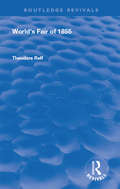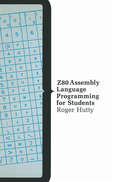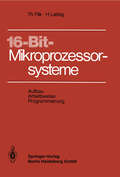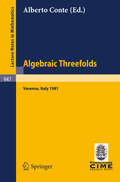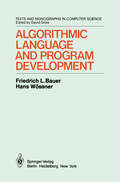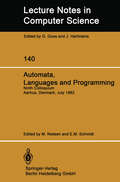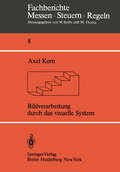- Table View
- List View
World's Fair of 1855 (Routledge Revivals)
by Theodore ReffPublished in 1981: This is two-hundred catalogues of the Major Exhibitions reproduced in facsimile in forty-seven volumes.
World's Fair of 1855 (Routledge Revivals)
by Theodore ReffPublished in 1981: This is two-hundred catalogues of the Major Exhibitions reproduced in facsimile in forty-seven volumes.
Algebraic Threefolds: Proceedings of the 2nd 1981 Session of the Centro Internazionale Matematico Estivo (C.I.M.E.), Held at Varenna, Italy, June 15-23, 1981 (Lecture Notes in Mathematics #947)
by Alberto ConteAlgorithmen der Netzwerkanalyse für programmierbare Taschenrechner (Anwendung programmierbarer Taschenrechner #12)
by Dieter LangeAlgorithmic Language and Program Development (Monographs in Computer Science)
by F.L. Bauer H. WössnerThe title of this book contains the words ALGORITHMIC LANGUAGE, in the singular. This is meant to convey the idea that it deals not so much with the diversity of program ming languages, but rather with their commonalities. The task of formal program develop It allows classifying ment proved to be the ideal frame for demonstrating this unity. concepts and distinguishing fundamental notions from notational features; and it leads immediately to a systematic disposition. This approach is supported by didactic, practical, and theoretical considerations. The clarity of the structure of a programming language de signed according to the principles of program transformation is remarkable. Of course there are various notations for such a language. The notation used in this book is mainly oriented towards ALGOL 68, but is also strongly influenced by PASCAL - it could equally well have been the other way round. In the appendices there are occa sional references to the styles used in ALGOL, PASCAL, LISP, and elsewhere.
Algorithms for Graphics and Image Processing
by T. PavlidisThe technological developments of the last ten years have made com puter graphics and image processing by computer popular. Pictorial pat tern recognition has also shown significant progress. Clearly, there exist overlapping interests among the three areas of research. Graphic displays are of concern to anyone involved in image processing or pic torial pattern recognition and many problems in graphics require methodologies from image processing for their solutions. The data structures used in all three areas are similar. It seems that there is a common body of knowledge underlying all three areas, pictorial informa tion processing by computer. The novelty of these fields makes it difficult to design a course or to a write a book covering their basic concepts. Some of the treatises on graphics focus on the hardware and methods of current interest while treatises on image processing often emphasize applications and classical signal processing. The fast evolution of technology causes such material to lose its relevance. For example, the development of optical fibers has reduced the importance of bandwidth compression.
All About Chess and Computers: Chess and Computers and More Chess and Computers
by D. Levy M. NewbornFor some time now, I have felt that the time is right to write a book about Computer Chess. Ever since the first attempts at chess pro gramming were made, some twenty five years ago, interest in the subject ha"s grown from year to year. During the late 1950s the subject was first brought to the attention of the public by an article in Scient(fic American, and less than a decade later a chess program was competing in a tournament with humans. More recently, there have been tournaments in which the only participants were computer programs. and when the first World Computer Championship was held in Stockholm in 1974 the event was an outstanding success. Laymen often doubt the value of investing in a subject so esoteric as computer chess, but there is definitely considerable benefit to be gained from a study of the automisation of chess and other intellectual games. If it proves possible to play such games well by computer, then the techniques employed to analyse and assess future positions in these games will also be useful in other problems in long-range planning. I have tried to make this book both interesting and instructive. Those who understand anything at all about chess but who have no knowledge of computers, will be able to follow my description of how computers play chess. Those with a knowledge of both areas will still find much to interest them.
Application and Theory of Petri Nets: Selected Papers from the First and the Second European Workshop on Application and Theory of Petri Nets Strasbourg, 23.–26. September 1980 Bad Honnef, 28.–30. September 1981 (Informatik-Fachberichte #52)
by C. Girault W. ReisigThis volume documents the progress of application and theory of Petri Nets since the Advanced Course on General Net Theory of Processes and Systems, held in Hamburg, October 8-19, 1979, This course presen ted in detail wha t had been achieved in this area since the first studies of concurrent systems 20 years ago, After this course it seemed worthwhile to establish a co-operation between different groups working in the field of Petri N ets, The starting points were the AFCET Special Interest Group "Systemes Paralleles et Distribues" and the Gl Special Interest Group "Petrinetze und verwandte Systemmodelle", Meanwhile, group s of many European countries are involved, A main activity of this co-operation is the realization of workshops in varying European countries, The first workshop of this kind was carried out in Strasbourg (France), September 23-26, 1980, The second one took place in Bad Honnef (Germany) September 28-30, 1981. This volume contains contributions of these two workshops, The 1980 workshop in Strasbourg was partitioned into 6 topics : (1) Application of Nets to Realtime Systems, (2) Programming Languages and Software Engineering, (3) Information Flow and Concurrency, (4) Net Morphisms and High Level Petri Nets, (5) Mathematical Analysis and N et Languages, (6) Reliability and Recovery Issues, In this volume, the chairman of each topic gives a short introduction to his area whict should help to understand its specific problems and to in troduce the presented papers,
The Application of Mathematics in Industry
by R.S. Anderssen F.R. de HoogThis publication reports the proceedings of a one-day seminar on The AppZicatian af Mathematics in Industry held at the Australian National University on Wednesday, December 3, 1980. It was organized jointly by the Division of Mathematics and Statistics, CSIRO, and the Departments of Pure and Applied Mathematics, The Faculty of Science, Australian National University. A paper based on the talk "Some uses of statistically designed experiments in industrial problems" given by N.B. Carter at the Seminar was not received by the editors. Though R.M. Lewis of John Lysaght (Australia) Limited did not present a talk, the editors invited him to submit a paper. They only learnt about his work after the program for the seminar had been finalized and publicized. His paper appears as the last paper in these proceedings and is entitled "A simple model for coil interior temperature prediction during batch annealing". The seminar was opened by Dr J.R. Philip, FAA, FRS, Director of the Physical Sciences Institute, CSIRO. He kindly agreed to supply an edited version of his comments for inclusion in the proceedings. They follow the Foreword as Opening Remarks.
The Architecture of High Performance Computers
by IBBETTIntroduction 1. 1 Historical Developments 1 1. 2 Techniques for Improving Performance 2 1. 3 An Architectural Design Example 3 2 Instructions and Addresses 2. 1 Three-address Systems - The CDC 6600 and 7600 7 2. 2 Two-address Systems - The IBM System/360 and /370 10 2. 3 One-address Systems 12 2. 4 Zero-address Systems 15 2. 5 The MU5 Instruction Set 17 2. 6 Comparing Instruction Formats 22 3 Storage Hierarcbies 3. 1 Store Interleaving 26 3. 2 The Atlas Paging System 29 3. 3 IBM Cache Systems 33 3. 4 The MU5 Name Store 37 3. 5 Data Transfers in the MU5 Storage Hierarchy 44 4 Pipelines 4. 1 The MU5 Primary Operand Unit Pipeline 49 4. 2 Arithmetic Pipelines - The TI ASC 62 4. 3 The IBM System/360 Model 91 Common Data Bus 67 5 Instruction Buffering 5. 1 The IBM System/360 Model 195 Instruction Processor 72 5. 2 Instruction Buffering in CDC Computers 77 5. 3 The MU5 Instruction Buffer Unit 82 5. 4 The CRAY-1 Instruction Buffers 87 5. 5 Position of the Control Point 89 6 Parallel Functional Units 6. 1 The CDC 6600 Central Processor 95 6. 2 The CDC 7600 Central Processor 104 6. 3 Performance 110 6 • 4 The CRA Y-1 112 7 Vector Processors 7. 1 Vector Facilities in MU5 126 7. 2 String Operations in MU5 136 7. 3 The CDC Star-100 142 7. 4 The CDC CYBER 205 146 7.
Automata, Languages and Programming: Ninth Colloquium Aarhus, Denmark, July 12–16, 1982 (Lecture Notes in Computer Science #140)
by M. Nielsen E. M. SchmidtBASIC für Fortgeschrittene: Textverarbeitung, Arbeiten mit logischen Größen, Computersimulation Arbeiten mit Zufallszahlen Unterprogrammtechnik (Programmieren von Mikrocomputern #3)
by Wolfgang SchneiderDer Band BASIC für Fortgeschrittene in der Reihe Programmieren von Mikrocomputern ist ein Aufbauband zum Grundlagenbuch Einführung in BASIC in der gleichen Buch reihe vom selben Autor. Es richtet sich aber auch an diejenigen Leser, die Grundkennt nisse in der Programmiersprache BASIC besitzen und ihre Kenntnisse in speziellen Be reichen erweitern möchten. Aus der Vielzahl der möglichen Einsatzbereiche der Programmiersprache BASIC wurden möglichst allgemein interessierende Bereiche ausgewählt, wie z.B. die ~extverarbeitung in BASIC, die Verarbeitung von logischen (Booleschen) Größen, das Arbeiten mit Zufalls zahlen und die Unterprogrammtechnik. Diese Bereiche wurden in einzelnen Kapiteln in sich geschlossen dargestellt. Eine Vielzahl von Beispielen verdeutlichen die Regeln. Das Wichtigste wird durch Merkregeln am Ende eines jeden Kapitels zusammengefaßt. Dies ist hilfreich, wenn später beim Programmieren eigener Programme schnell nachgeschlagen werden soll. Mit Hilfe von selbst zu lösenden Übungsaufgaben kann der Leser überprüfen, ob er die BASIC-Regeln der einzelnen Kapitel beherrscht. Die richtigen Lösungen findet er am Ende des Buches. Das letzte Kapitel des Buches enthält 1 0 voll kommen programmierte und kommentierte Beispiele. Hier soll gezeigt werden, wie man das Wissen der einzelnen Kapitel nutzbrin gend anwendet. Es wird u.a. gezeigt, wie man mit Hilfe des Mikrocomputers Texte ver schlüsseln und anschließend wieder entschlüsseln kann, wie man den Mikrocomputer als Spielpartner einsetzt oder wie man ihn zum Schreiben von Rechnungen benutzen kann und wie man ihn programmieren muß, damit er alphabetisch ungeordnete Worte, z.B. eine ungeordnete Namensliste, alphabetisch ordnet und dgl.
Biomedical Images and Computers: Selected Papers Presented at the United States-France Seminar on Biomedical Image Processing, St. Pierre de Chartreuse, France, May 27–31, 1980 (Lecture Notes in Medical Informatics #17)
by J. Sklansky J. C. BisconteThe technology of automatic pattern recognition and digital image processing, after over two decades of basic research, is now appearing in important applications in biology and medicine as weIl as industrial, military and aerospace systems. In response to a suggestion from Mr. Norman Caplan, ·the Program Director for Automation, Bioengineering and Sensing at the United States National Science Foundation, the authors of this book organized the first Uni ted States-France Seminar on Biomedical Image Processing. The seminar met at the Hotel Beau Site, St. Pierre de Chartreuse, France on May 27-31, 1980. This book contains most of the papers presented at this seminar, as weIl as two papers (by Bisconte et al. and by Ploem ~ al.) discussed at the seminar but not appearing on the program. We view the subject matter of this seminar as a confluence amon~ three broad scientific and engineering disciplines: 1) biology and medicine, 2) imaging and optics, and 3) computer science and computer engineering. The seminar had three objectives: 1) to discuss the state of the art of biomedical image processing with emphasis on four themes: microscopic image analysis, radiological image analysis, tomography, and image processing technology; 2) to place values on directions for future research so as to give guidance to agencies supporting such research; and 3) to explore and encourage various areas of cooperative research between French and Uni ted States scientists within the field of Biomedical Image Processing.
Büroinformations- und -kommunikationssysteme: Anwendergespräch, Wirtschaftsuniversität Wien, 30.9. bis 1.10.1982 (Betriebs- und Wirtschaftsinformatik #2)
by H. R. HansenCOMPSTAT 1982 5th Symposium held at Toulouse 1982: Part I: Proceedings in Computational Statistics
by H. Caussinus P. Ettinger R. TomassoneComputational Methods and Experimental Measurements: Proceedings of the International Conference, Washington D.C., July 1982
by G. A. Keramidas C. A. BrebbiaSponsored by the International Society for Computational Methods in Engineering
Computer Algebra: Symbolic and Algebraic Computation (Computing Supplementa #4)
by R. AlbrechtThe journal Computing has established a series of supplement volumes the fourth of which appears this year. Its purpose is to provide a coherent presentation of a new topic in a single volume. The previous subjects were Computer Arithmetic 1977, Fundamentals of Numerical Computation 1980, and Parallel Processes and Related Automata 1981; the topic of this 1982 Supplementum to Computing is Computer Algebra. This subject, which emerged in the early nineteen sixties, has also been referred to as "symbolic and algebraic computation" or "formula manipulation". Algebraic algorithms have been receiving increasing interest as a result of the recognition of the central role of algorithms in computer science. They can be easily specified in a formal and rigorous way and provide solutions to problems known and studied for a long time. Whereas traditional algebra is concerned with constructive methods, computer algebra is furthermore interested in efficiency, in implementation, and in hardware and software aspects of the algorithms. It develops that in deciding effectiveness and determining efficiency of algebraic methods many other tools - recursion theory, logic, analysis and combinatorics, for example - are necessary. In the beginning of the use of computers for symbolic algebra it soon became apparent that the straightforward textbook methods were often very inefficient. Instead of turning to numerical approximation methods, computer algebra studies systematically the sources of the inefficiency and searches for alternative algebraic methods to improve or even replace the algorithms.
Computer Communications
by R. COLEThe subject of computer communications is changing very rapidly. Improvements in terminal access, aligned with the development of timesharing, has brought hands-on experience to a large number of non specialist users. Computer networks have made available vast computing resources and data banks to these users. This book is for anyone familiar with using computers who wishes to understand the techniques used in computer communications. It is also an introduction to the architecture of present day computer communication systems. I would like to thank Roland lbbett, Steve Treadwell, Peter Kirstein and Del Thomas for their invaluable advice and encouragement. My thanks also to Malcolm Stewart and the staff at Macmillan. The late Gareth Pugh encouraged my interest in computer communications and provided the opportunity to develop the material for this book. The text was formatted on a UNIX computer system: I am grateful to Professor Kirstein for permission to use this system. I am indebted to NEC Telecommunications Europe for the use of a spinwriter printer on which the master copy was produced. Finally, no amount of words can express my debt to Jo this project and Rosemary for patiently bearing with over the last three years.
Computers and the General Practitioner: Proceedings of the GP-Info Symposium, London, 1980
by Alastair Malcolm John PoyserComputers and the General Practitioner focuses on the applications of computers in various aspects of health service, including ECG analysis, primary care, and diagnosis. The selection first tackles general practice and technological promise and experience of pioneers. Topics include information systems and general practice, trends in silicon chip technology, and problems of computer usage in National Health Service practice. The publication then examines security in computer controlled information systems and national strategy for primary care computing, including security defenses, linked systems, cryptography, and basic system. The text takes a look at the computer education of the general practitioner, use of computers in the consulting room, and ECG analysis by computer in general practice. Discussions focus on the problems associated with educating doctors, features of a heuristic system, and the function of the computer as a general practitioner's diagnostic assistant. The selection is a dependable source of data for doctors and readers interested in exploring the applications of computers in health services.
